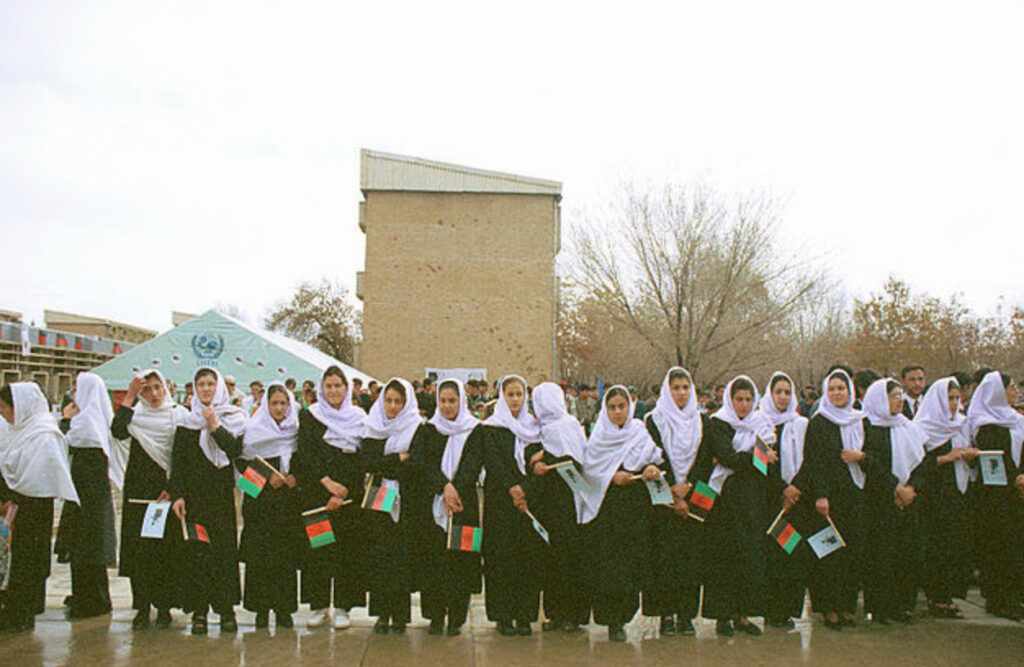LOS ANGELES — As the Taliban closes in on women’s rights following their seizure of power, the state of female schooling hangs in the balance; the future of women’s education in the country is marred with uncertainty, contradiction and fear.
The Taliban have promised change from their previous rule, vowing that they will allow women to learn. The Higher Education Minister Abdul Baqi Haqqani stated on September 12 that women would be allowed to study through high school and at a university level so long as the students remain segregated by gender.
Yet, as the academic year commenced under the Taliban and students trickled back into classrooms, girls grades 7 and up were notably missing. Taliban spokesman Zabiullah Mujahid blamed the delay on logistical issues, claiming that the Taliban is still attempting to create a “secure transportation system” for girls. Yet in recent days, the Chancellor for Kabul University, Mohammad Ashraf Ghairat, has made conflicting comments, saying that women will not be allowed to study in the institution “until we create an Islamic environment.” What that “Islamic environment” entails, and what the timeline for its completion might potentially be, remains unclear.
Women in Afghanistan hold deep angst that the Taliban’s assurances concerning their education are empty promises; they fear that the “delays” in allowing them to continue schooling will never be resolved. This uncertainty has sparked protests across the country. In late September, a social media campaign featuring young Afghan boys and girls holding signs with messages of support for female education culminated in more than a dozen women gathering outside the Kabul mayoral ministry as a sign of dissent. The teacher’s union of Afghanistan has also sent a petition to the Taliban demanding Ghairat’s resignation.
However, for all protestors’ efforts, the Taliban has never held a reputation for upholding democratic values. Should the hardliners choose to restrict female education, which seems more probable with each passing day, Afghan women will have no choice but to stay home from school.
Nonetheless, should this regulation be an ultimatum for if women will be able to learn? Afghanistan is becoming more and more tech-savvy, and most people in urban areas now have a smartphone which the Taliban has been using to its advantage to spread propaganda across social media. As the COVID-19 pandemic has proven, staying home from school does not necessitate an end to education. Virtual learning has reached unprecedented heights and potential in the advent of multiple lockdowns. Could that potential be applied to Afghanistan and allow its women to circumvent the restrictions of their government?
A surface-level analysis provides a cynical outlook. Multiple obstacles construe the viability of such a solution. First and foremost is the issue of resources. While there are the few privileged in urban areas with access to technology, the overwhelming majority do not have the means to make online learning feasible.
According to the World Bank, only 14% of Afghans use the internet. Expanding upon that worrisome data, across six Afghan provinces only 0.2% of children have access to internet-based learning programs, as per Save the Children. Even for that 0.2%, the electricity in Kabul only runs for a couple of hours per day, and moving into the countryside, state-provided power is incredibly limited.
During the 2020-2021 academic year, while the U.S.-backed government was still in power and encouraging education, the vast majority of Afghan students still found their education totally halted. That leaves the possibility of finding the means to learn now, minimal.
On top of insufficient means is the overarching difficulty of evading the Taliban’s watchful eye. In a largely totalitarian regime, under the unlikely assumption she has access to online school, a woman would still be putting as much as her life at risk by deciding to defy the Taliban’s wishes. Moreover, she would have to elude much more than neighborhood watches or overly-curious neighbors: the Taliban now has access to the ultimate tool for repression, a US-built online database.
The Afghanistan Automated Biometric Identification Database, constructed over decades and with millions of dollars in investment, contains a mine of information for the Taliban to exploit. It includes biometrics, such as fingerprint, iris and face scans, for identification, as well as the phone numbers, locations and several more personal details for 8.5 million people. With this incredibly powerful database at their disposal, the government could very well transition into a surveillance state, making it next-to-impossible for the average Afghan female to pursue virtual learning.
Where does this leave the women of Afghanistan, then?
Largely at the discretion of the Taliban, it would seem. There is some promising news on the horizon. At a recent United Nations-led panel discussion, Deputy Secretary-General Amina Mohammed announced that the education of Afghan girls is a “zero-condition” before the Taliban can expect international recognition of their authority, even claiming that aid sent to the country could be conditional depending on if schools are opened up to girls.
This pressure from the international community may be the best instrument to pressure the Taliban on women’s rights, especially considering the group has made clear they seek formal international recognition.
At present, though, the Taliban’s next steps are not certain. For the thousands of Afghan women trapped at home and seeking education, foreign recognition, awareness and advocacy have never been more crucial.






